Scandinavian Bracteat
Scandinavian bracteate (from the Latin bractea - a thin piece of metal), other names - Nordic b., Germanic b.; a circular unifacially ornamented gold pendant from the →Migration Period with a central decorative motif impressed onto the metal sheet by striking from the obverse with a metal die. S.b. are fitted with a loop, usually decorative and a rim wire. Depending on their central iconographic motif s.b. are distinguished into six types, A-F. Common motifs are stylised heads and representations of humans and animals, often fantastic, and one of the most frequent images is that of a male head over a stylised horse-like animal (type C) which may be interpreted as Odin with his son Baldr’s lamed horse. Some s.b. (about 11%) have short runic inscriptions, and many include various symbols, for example, swastikas. S.b. are dated to the 5th and the 6th century. They were inspired by late Roman gold coins and medallions offered as gifts to the members of the Germanic power elite →Germanic Tribes . In the North local goldsmiths fitted the coins and medallions with loops and frames. During the 4th century the first barbarian imitations of Roman medallions appear, some struck unifacially, as possible forerunners of s.b. although an alternative origin of s.b. is also likely. Over 1000 specimens of s.b. are known, mostly from south Scandinavia, but also eastern England, Germany, and as far south as Hungary. They have been discovered in hoards, graves and as stray finds. Presumably, their function was that of amulets worn suspended around the neck, possibly also as power and prestige symbols of the local elites, which could be circulated in the interregional gifts exchange. Polish finds of s.b. include a total of 15 s.b., from four hoards discovered in Pomerania (→Karlino , →Suchań [Fig. 1]) and Great Poland (→Wapno [Fig. 2], →Zagorzyn [Fig. 3]). They document the presence of newcomers from Scandinavia, especially, from Bornholm, Funen and Scania. The largest collections of s.b. are in the national museums in Copenhagen and Stockholm. Two s.b. from the Polish finds are in the National Museum in Szczecin, while most of the others are in the Pushkin State Museum of Fine Arts in Moscow.
AB
Literature: B. Salin, De nordiska guldbrakteaterne, Antiqvarisk Tidskrift för Sverige 14,2, p. 1-111; M. B. Mackeprang, De Nordiske Guldbrakteater, Jysk Arkæologisk Selskabs Skrifter Bind II, Aarhus 1952; P.-O. Bohlin, Brakteatteknik, Uppsala 1981; M. Axboe, The Scandinavian gold bracteates. Studies on their manufacture and regional variation, Acta Archaeologica 52 (1981), 1982, p. 1-100; M. Axboe, K. Düwel, K. Hauck, L. von Padberg et alii, Die Goldbrakteaten der Völkerwanderungszeit, Ikonographischer Katalog, Münstersche Mittelalterschriften, 24, vol. 1-3, München 1985-1989; K. Hauck (ed.), Der historische Horizont der Götterbild-Amulette der Übergangsepoche von der Spätantike zum Frühmittelalter, Münster 1992; M. Gaimster, Vendel Period Bracteates on Gotland. On the Significance of Germanic Art, Lund 1998; M. Axboe, Die Goldbrakteaten der Völkerwanderungszeit. Herstellungsprobleme und Chronologie, RGA-E vol. 38, Berlin – New York 2004; M. Axboe, Brakteatstudier, Det Kongelige Nordiske Oldskriftselskab, København 2007; A. Pesch, Die Goldbrakteaten der Völkerwanderungszeit – Thema und Variation, Ergänzungsbände zum Reallexikon der Germanischen Altertumskunde 36, Berlin – New York 2007; W. Heizmann, M. Axboe, Die Goldbrakteaten der Völkerwanderungszeit – Auswertung und Neufunde, RGA-E vol. 40, Berlin – New York 2011.
-
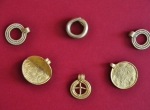 full resolution
full resolution
Fig. 1. Type C bracteats and pendants from Suchań, distr. Stargard, National Museum in Szczecin (photo K. Kowalski).
-
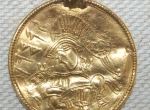 full resolution
full resolution
Fig. 2. Type C bracteat from Wapno, distr. Wągrowiec, Vor- und Frühgeschichte Museum, Berlin (photo A. Bursche).
-
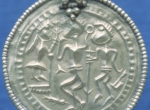 full resolution
full resolution
Fig. 3. Type B bracteat from Zagorzyn, distr. Kalisz, Württembergisches Landesmuseum Stuttgart (photo U. Klein).
-
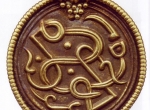 full resolution
full resolution
Fig. 4. Type D bracteat.
-
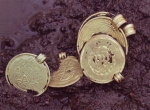 full resolution
full resolution
Fig. 5. A bracteat deposit in situ, Sorte Muld, Bornholm.


